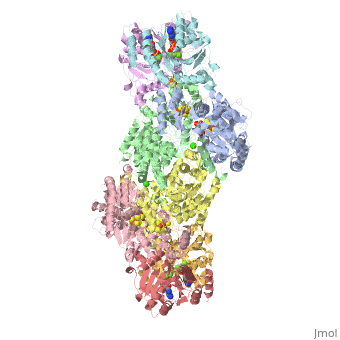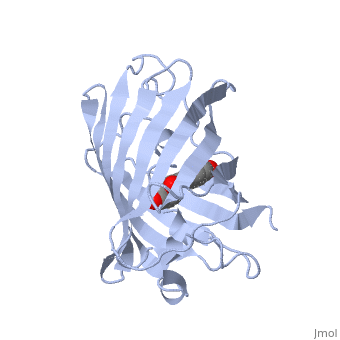Nitrogenase
From Proteopedia
| Line 1: | Line 1: | ||
| - | Please do NOT make changes to this sandbox. Sandboxes 10-30 are reserved by Prof. Sheila Jaswal at Amherst College. | + | Please do NOT make changes to this sandbox. Sandboxes 10-30 are currently reserved by Prof. Sheila Jaswal at Amherst College. |
| Line 11: | Line 11: | ||
N<sub>2</sub> + 8 H<sup>+</sup> + 16 MgATP + 8 e<sup>-</sup> → 2NH<sub>3</sub> + H<sub>2</sub> + 16 MgADP + 16 P<sub>i</sub> | N<sub>2</sub> + 8 H<sup>+</sup> + 16 MgATP + 8 e<sup>-</sup> → 2NH<sub>3</sub> + H<sub>2</sub> + 16 MgADP + 16 P<sub>i</sub> | ||
| - | Two different proteins comprise the nitrogenase complex. The FeMo protein binds substrate and reduces H+ and | + | Two different proteins comprise the nitrogenase complex. The FeMo protein binds substrate and reduces H<sup>+</sup> and N<sub>2</sub> to H<sub>2</sub> and ammonia, while the Fe protein receives electrons from ferredoxin, hydrolyzes ATP, and reduces the FeMo protein. To the right is shown a crystal structure where two complexes of FeMo protein bound to Fe protein were crystallized together. <scene name='Sandbox_10/1n2c_single_complex/1'>Click here to see only one complex.</scene> |
| - | [[Image:1ema BIOmics 10.gif |350px]] | ||
Green fluorescent protein ('''GFP'''), originally isolated from the jellyfish Aequorea victoria (PDB entry [[1ema]]), fluorsceses green (509nm) when exposed to blue light (395nm and 475nm). It is one of the most important proteins used in biological research because it can be used to tag otherwise invisible gene products of interest and thus observe their existence, location and movement. | Green fluorescent protein ('''GFP'''), originally isolated from the jellyfish Aequorea victoria (PDB entry [[1ema]]), fluorsceses green (509nm) when exposed to blue light (395nm and 475nm). It is one of the most important proteins used in biological research because it can be used to tag otherwise invisible gene products of interest and thus observe their existence, location and movement. | ||
Revision as of 18:46, 20 June 2010
Please do NOT make changes to this sandbox. Sandboxes 10-30 are currently reserved by Prof. Sheila Jaswal at Amherst College.
Nitrogenase
|
Nitrogenase is an enzyme that fixes atmospheric nitrogen (N2) into ammonia. Though abundantly present in the atmosphere, most organisms cannot utilize N2 directly, and must instead take it in through other forms, like ammonia or nitrate. The triple bond in N2 is highly resistant to changes in oxidation state, and nitrogenases, found only in nitrogen-fixing bacteria, are the only proteins capable of reducing N2 to ammonia.
Nitrogenase catalyzes the following reaction:
N2 + 8 H+ + 16 MgATP + 8 e- → 2NH3 + H2 + 16 MgADP + 16 Pi
Two different proteins comprise the nitrogenase complex. The FeMo protein binds substrate and reduces H+ and N2 to H2 and ammonia, while the Fe protein receives electrons from ferredoxin, hydrolyzes ATP, and reduces the FeMo protein. To the right is shown a crystal structure where two complexes of FeMo protein bound to Fe protein were crystallized together.
Green fluorescent protein (GFP), originally isolated from the jellyfish Aequorea victoria (PDB entry 1ema), fluorsceses green (509nm) when exposed to blue light (395nm and 475nm). It is one of the most important proteins used in biological research because it can be used to tag otherwise invisible gene products of interest and thus observe their existence, location and movement.
Exploring the Structure
|
GFP is a beta barrel protein with 11 beta sheets. It is a 26.9kDa protein made up of 238 amino acids. The , responsible for the fluorescent properties of the protein, is buried inside the beta barrel as part of the central alpha helix passing through the barrel. The chromophore forms via spontaneous cyclization and oxidation of three residues in the central alpha helix: -Thr65 (or Ser65)-Tyr66-Gly67. This cyclization and oxidation creates the chromophore's five-membered ring via a new bond between the threonine and the glycine residues.[1]
References
- ↑ Ormo M, Cubitt AB, Kallio K, Gross LA, Tsien RY, Remington SJ. Crystal structure of the Aequorea victoria green fluorescent protein. Science. 1996 Sep 6;273(5280):1392-5. PMID:8703075
Proteopedia Page Contributors and Editors (what is this?)
Michal Harel, Alexander Berchansky, Eran Hodis, David Canner, Joel L. Sussman


